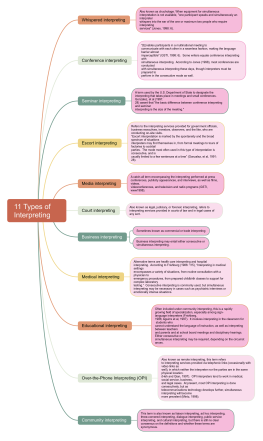
11 loại hình phiên dịch
2 Báo Cáo
11 loại hình phiên dịch
Khuyến nghị liên quan
Các tác phẩm khác của tác giả
Phác thảo/Nội dung
Xem thêm
Whispered interpreting
Also known as chuchotage. When equipment for simultaneous
interpretation is not available, "one participant speaks and simultaneously an interpreter
whispers into the ear of the one or maximum two people who require interpreting
services" (Jones, 1998: 6).
interpretation is not available, "one participant speaks and simultaneously an interpreter
whispers into the ear of the one or maximum two people who require interpreting
services" (Jones, 1998: 6).
Conference interpreting
"(E)nables participants in a multinational meeting to
communicate with each other in a seamless fashion, making the language barrier almost
imperceptible" (GSTI, 1998: 6). Some writers equate conference interpreting with
simultaneous interpreting. According to Jones (1998), most conferences are conducted
with simultaneous interpreting these days, though interpreters must be prepared to
perform in the consecutive mode as well.
communicate with each other in a seamless fashion, making the language barrier almost
imperceptible" (GSTI, 1998: 6). Some writers equate conference interpreting with
simultaneous interpreting. According to Jones (1998), most conferences are conducted
with simultaneous interpreting these days, though interpreters must be prepared to
perform in the consecutive mode as well.
Seminar interpreting
A term used by the U.S. Department of State to designate the
interpreting that takes place in meetings and small conferences. Gonzalez, et al (1991:
28) assert that "the basic difference between conference interpreting and seminar
interpreting is the size of the meeting."
interpreting that takes place in meetings and small conferences. Gonzalez, et al (1991:
28) assert that "the basic difference between conference interpreting and seminar
interpreting is the size of the meeting."
Escort interpreting
Refers to the interpreting services provided for government officials,
business executives, investors, observers, and the like, who are conducting on-site visits.
“Escort interpretation is marked by the spontaneity and the broad spectrum of situations
interpreters may find themselves in, from formal meetings to tours of factories to cocktail
parties. The mode most often used in this type of interpretation is consecutive, and is
usually limited to a few sentences at a time” (Gonzalez, et al, 1991: 28).
business executives, investors, observers, and the like, who are conducting on-site visits.
“Escort interpretation is marked by the spontaneity and the broad spectrum of situations
interpreters may find themselves in, from formal meetings to tours of factories to cocktail
parties. The mode most often used in this type of interpretation is consecutive, and is
usually limited to a few sentences at a time” (Gonzalez, et al, 1991: 28).
Media interpreting
A catch-all term encompassing the interpreting performed at press
conferences, publicity appearances, and interviews, as well as films, videos,
videoconferences, and television and radio programs (GSTI, www1998).
conferences, publicity appearances, and interviews, as well as films, videos,
videoconferences, and television and radio programs (GSTI, www1998).
Court interpreting
Also known as legal, judiciary, or forensic interpreting, refers to
interpreting services provided in courts of law and in legal cases of any sort.
interpreting services provided in courts of law and in legal cases of any sort.
Business interpreting
Sometimes known as commercial or trade interpreting
Business interpreting may entail either consecutive or
simultaneous interpreting.
simultaneous interpreting.
Medical interpreting
Alternative terms are health care interpreting and hospital
interpreting. According to Frishberg (1986: 115), “Interpreting in medical settings
encompasses a variety of situations, from routine consultation with a physician to
emergency procedures, from prepared childbirth classes to support for complex laboratory
testing.” Consecutive interpreting is commonly used, but simultaneous interpreting may be necessary in cases such as psychiatric interviews or emotionally intense situations.
interpreting. According to Frishberg (1986: 115), “Interpreting in medical settings
encompasses a variety of situations, from routine consultation with a physician to
emergency procedures, from prepared childbirth classes to support for complex laboratory
testing.” Consecutive interpreting is commonly used, but simultaneous interpreting may be necessary in cases such as psychiatric interviews or emotionally intense situations.
Educational interpreting
Often included under community interpreting, this is a rapidly
growing field of specialization, especially among sign-language interpreters (Frishberg,
1986; Aguirre et al, 1997). It involves interpreting in the classroom for students who
cannot understand the language of instruction, as well as interpreting between teachers
and parents and at school board meetings and disciplinary hearings. Either consecutive or
simultaneous interpreting may be required, depending on the circumstances.
Over-the-Phone Interpreting (OPI)
Also known as remote interpreting, this term refers
to interpreting services provided via telephonic links (occasionally with video links as
well), in which neither the interpreter nor the parties are in the same physical location.
(Heh and Qian, 1997). OPI interpreters tend to work in medical, social service, business,
and legal cases. At present, most OPI interpreting is done consecutively, but as
telecommunications technology develops further, simultaneous interpreting will become
more prevalent (Mintz, 1998).
to interpreting services provided via telephonic links (occasionally with video links as
well), in which neither the interpreter nor the parties are in the same physical location.
(Heh and Qian, 1997). OPI interpreters tend to work in medical, social service, business,
and legal cases. At present, most OPI interpreting is done consecutively, but as
telecommunications technology develops further, simultaneous interpreting will become
more prevalent (Mintz, 1998).
Community interpreting
This term is also known as liaison interpreting, ad hoc interpreting, three-cornered interpreting, dialogue interpreting, public service interpreting, and cultural interpreting, but there is still no clear consensus on the definitions and whether these terms are synonymous.

Sưu Tầm

0 Bình luận
Trang tiếp theo



